Core Principles and Concepts
The circular economy is a relative novelty in the field of economics. It promises the change for a more sustainable, cost-effective, and environmentally-friendly environment that many societies, both developed and developing, can benefit from. However, many people familiar with the concept lack a profound understanding of its mechanism, benefits, and role in business, finance, and societal contexts. Thus, the precise definition and knowledge of the concept are needed to assess circular economies adequately and efficiently implement them. This essay will focus on defining the circular economy, investigating its core principles, exploring its role in societal, financial, and business transformation, and discuss some possible implications for modern contexts.
Circular Economy: Solution to the Problem
The creation of the circular economy would have been impossible without the current system’s failure that which most societies and businesses operate. Merli, Preziosi, and Acampora (2018) claim that one of the easiest ways to understand a circular economy is to compare it to the linear one and draw the major differences. Linear economy, according to Sassanelli et al. (2019, p. 440), operates on the principle of “take-make-dispose.” To elaborate, this simplified formula highlights that the economy evolved in a way that allows individuals and entities to seek the most profit and benefit for themselves without any regard for long-term consequences. This approach focuses on taking the needed resources with little attention to their extraction process, and the result of these actions is to satisfy consumers’ needs. One then disposes of any waste done in the process by simple means of pollution (Vanhamäki et al., 2020). Via this model, resources have a straightforward, linear journey in the consumerism chain by being gathered, transformed into products, and then thrown out.
As evident from the current state of the environment and global economy, the linear system, though sufficient for instant gratification of short-term needs, is not a viable approach to creating a sustainable future. Vanhamäki et al. (2020) have shown that the rapid industrial revolution significantly disrupted the natural balance of resources and created a major problem for the global climate, socioeconomic stability, and business making. For instance, the linear economy concept resulted in the accumulation of an abundance of waste and, as a result, water and air pollution that affects not only the most industrialized regions but the whole world. The high level of consumerism also allowed for an uneven distribution of wealth and inherent inequality within the social hierarchy.
Definition
As a result of the aforementioned harmful processes that were spurred by the linear economy, the concept of circular economy as a solution to the given issues has been developed. It is defined by Sassanelli et al. (2019, p. 441) as “an industrial system that is restorative or regenerative.” More specifically, this type of economy aims at closing the loop of consumerism that linear mechanism has promoted and find a use for waste instead of abolishing it (Merli, Preziosi, and Acampora, 2018). This approach differs drastically from the linear economy model since it repurposes the items, creating a circle of consumption with little to no need for new recourse gathering (Merli, Preziosi, and Acampora, 2018). Instead of taking from nature, the system’s resources are restored virtually forever, eliminating the end-of-life concept.
Circular Economy Frameworks
When discussing circular economies, it is necessary to overview some of the schools of thought that greatly contribute to the development of the framework. Perhaps, one of the most relevant theories is the cradle-to-cradle philosophy. Ünal and Shao (2018) argue that it is one of the most practically-oriented approaches since it operates on specific standards and certifications that assess the products according to five categories. According to Ünal and Shao (2018, p. 755), the cradle-to-cradle approach is “a more operationalized version of a circular economy by serving as a proxy for measuring circular economy achievements.” Product in a cradle-to-cradle economy must be materially healthy, have reutilization potential, and be produced via renewable energy (Ünal and Shao, 2018). The manufacturers also have to adhere to water stewardship and social fairness principles.
The second theory that can be considered a building block of the circular economy is the biomimicry model introduced by Janine Benyus. This framework generally emphasizes the importance of recognizing valuable consumption loops in nature and projecting that knowledge onto human development. For instance, it argues that for any product to be a part of the successful circular loop, “relation between assets spend for value recovery
and recovered value is needed” (Bockholt et al., 2019, p. 874). Similar to the concept of mimicry, Gunter Pauli created the theory of the blue economy that primarily focuses on the so-called metabolism of the consumption system (Bockholt et al., 2019).
Relevant Concepts: Biological and Technical Loops
In order to comprehensively address the mechanisms of circular economies, it is essential to examine the relevant concepts and critical processes. The graph below showcases the general resource dynamic of the circular economy; evidently, it focuses on a division between biological and technical resources that both require different approaches. Firstly, as per the system’s natural side, the concept attempts to minimize labelling organic products as waste. Instead, the nutrients left behind after the first cycle of usage “cascade” back into consumption in the different relevant forms.
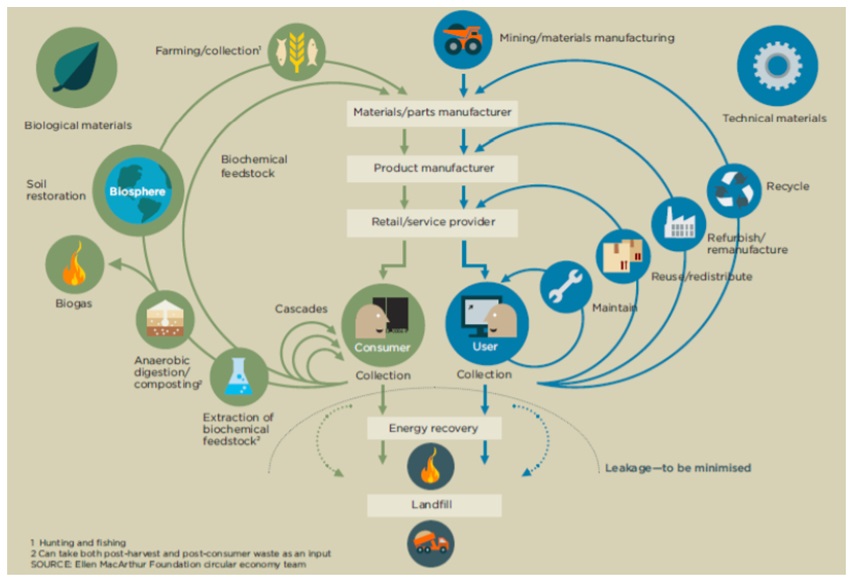
The process repeats itself until the potential of a particular product is depleted completely – then, it can be disposed of sustainably. The biological loop can be examined through the perspective provided by Vanhamäki et al. (2020) in their study on closing consumption loops in a regional context. Vanhamäki et al. (2020, p. 104) argue that the so-called “bioeconomy” is a critical changemaker in the field of circular systems. Vanhamäki et al. (2020) provide the example of Finland where organic waste has been banned from landfills in 2016. This policy cultivated the motivation for businesses to develop into the direction of recycling and repurposing of the biological resources. Any biological material can be repurposed for a product of a similar value, used to ferment the ground, and utilized to collect valuable emissions from the decomposition process.
The second part of the system focuses on the technological resources and the possible ways to close the consumption loops. First of all, the technology can be continuously maintained in working condition to satisfy the users’ needs and prolong the life cycle of the original product (Sposato et al., 2017). If it becomes undesirable by the initial user, the circular economy can return the item to the retailer to resell it as a used but still functioning piece of technology (Sposato et al., 2017). The product can also be refurbished by the manufacturer of technological goods, giving the resource the second cycle of life.
Lastly, if the technological resource becomes impossible to remanufacture, its parts can be repurposed to create the new pieces of technology since the value of the materials is not minimized during the consumption process. This side of the cycle focuses on making the lifespan of technology as long as possible (Sposato et al., 2017). When it eventually ends, people make it fuel the creation of new items instead of gathering new resources from the natural world.
A Transition Towards Circular Economies: Implications and Necessary Shifts
Given the circular economy’s multidimensional effects on everyday functions, its implementation will rely on equal support from local businesses and global policymaking. As per the business aspect, the Finnish economy’s case shows that any industry can seamlessly transition to the circular economy model with great benefits for employees, consumers, and profit generation (Vanhamäki et al., 2020). However, while global change is needed for the economic transition, not all companies will be willing to make such drastic changes. In this case, this is where policymaking will play a significant role. More specifically, taxation of fossil fuel and single-use manufacturers will spur growth since it will encourage both businesses and customers to move towards cheaper and, consequently, more sustainable options. In addition, governmental grants and other non-financial support of businesses necessary for closing the loops is essential in establishing an efficient platform for circular economy development and growth (Sposato et al., 2017). Thus, the government should implement programs facilitating businesses that repurpose, recycle, and redistribute goods.
While the circular economy is targeted towards making a positive impact on the environment, it undoubtedly affects businesses and consumers involved in the process. Kirchherr, Reike, and Hekkert (2017, p. 221) emphasize that “industrial symbiosis, ecosystems, and networks among companies constitute the meso level, whereas the micro-level focuses on single companies and consumers.” If to look at the impact of the circular economy on businesses, it yields fundamental changes with both beneficial and arguably harmful effects. For instance, on the downside, the presence of a system that can supply manufacturing materials without the need to extract virgin resources puts industries like those profiting from fossil fuels at risk. Furthermore, the large-scale implementation of the system is projected to change the supply and demand dynamic. Conversely, “because significant share of commodities will be used to build up infrastructure and thus accumulate in societies’ material stock,” circular economy is a viable framework to create stability (Fellner et al., 2017, p. 494). Lastly, it is essential to address the fact that circular economies contribute to the overall stability of the system and make it more resilient.
From the consumer’s perspective, the shift towards more sustainable economies will be beneficial. For example, customers will enjoy the new products more since they will last longer and be repurposed multiple times. Furthermore, low-income individuals will have the ability to access technology by being significant actors in second loops of the used products. More than that, the circular economy promotes sustainability and, in the long-term, reduces costs for energy and resource consumption, which will increase the quality of life (Fellner et al., 2017). Resource conservation, being one of the main reasons for the framework implementation, will not only allow current users to enjoy cleaner environment but also contribute to the healthy development of the future generations.
If to consider the role of information, finances, and social capital, a significant shift is needed. Merli, Preziosi, and Acampora (2018) propose to view money not only as a financial asset in a circular economy but also as a set of information about the way a specific product was made. More specifically, a price and informational value for a single-use product in a linear economy will differ from the price of a repurposed item in a closed loop of the circular economy. Merli, Preziosi, and Acampora (2018) argue that an informational role of money will need to change and become more prominent once the circular economy is implemented. This will also mean that the financial and information flows will change and become more transparent instead of a vague reflection of linear economies.
Lastly, the shift in the value of social capital would be fundamental in circular economies. Social capital is measured by the extent to which individuals are willing to contribute to the common good without the financial incentive (Merli, Preziosi, and Acampora, 2018). The concept is also characterized by the way residents willingly engage in civil decision-making with no personal gain. In the individualistic linear economy of the current world, citizens care for their well-being with little to no regard for the environment. The circular economy is projected to change that since establishing functional consumption loops requires considerable investment, policymaking, and individual initiative. Thus, the modern perception of autonomy and independence will have to shift in favour of viewing a person as a part of the bigger group. Overall, the social capital feature concludes the needed transition from linear to circular economies. People have to have a long-term view of the future and work collectively to establish systems that work for the common good of both people and the environment instead of consumeristic short-term profit.
Circular Economy in Riyadh, Saudi Arabia
Riyadh, being the capital of Saudi Arabia, is a system with complex infrastructure. The city hosts close to 30 million residents, Saudi Arabia citizens and foreigners, and struggles with pollution and waste management. According to Mu’azu et al. (2018), Riyadh is one of the most polluted places on Earth. Although there are currently ongoing interventions to minimize the region’s pollution and increase the capital’s cleanliness, the government efforts do not yield effective enough results to mitigate the existing issues. This assessment report will address Riyadh’s linear economy system’s major problems, reflect on how an ideal circular economy can work in the city’s context, and outline the necessary changes to perform the positive shift.
Linear City
Firstly, it is essential to address the existing issues that the linear economy of Riyadh creates. The system is characterized by a lot of waste generation, resulting in adverse effects on the environment. One of the significant issues in Saudi Arabia and Riyadh is the lack of organic waste management. Due to the current system’s linearity, Saudi Arabia ranks 22th among all countries according to their food sustainability index (Mu’azu et al., 2018). Although this statistic shows that the country’s situation is not as adverse as in some world regions, there is still room for growth. Furthermore, while the research provides comparatively good results for the country as a whole, further investigation by Mu’azu et al. (2018) finds that food management in the capital is much less promising. More specifically, more than half of all the municipal solid waste produced by Riyadh is food.
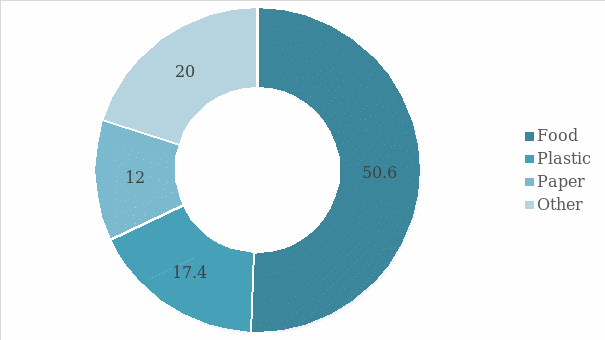
These findings prove that the bioresource loop is far from being circular in Riyadh’s local economy. The length of food products’ life sometimes is so small that the fresh and edible nutrients are being disposed of due to poor management among local businesses (Baig, Gorski, and Neff, 2019). As a result of such mistreatment, organic waste becomes the centre of the capital’s linear economy as the significant end-of-life issue. It not only generates losses for businesses but also contributes to the growth of prices on fresh products. Due to the region’s cultural peculiarities, a large amount of food is wasted as a result of religious practices. During Ramadan and pilgrimage season, the food waste is estimated at 5000 tons annually (Baig, Gorski, and Neff, 2019, p. 1637). If not disturbed and innovated, this process will cultivate an abundance of waste that pollutes the environment and generate more turbulence in the food market, aggravating the existing fragile balance between supply and demand.
The second issue worth mentioning is the lack of renewable resources used in the region. Despite having promising potential for using solar and wind energy that the area is abundant in, the planet’s fossil fuels remain the primary source of energy for Riyadh. It might be economically beneficial at first glance since the local natural gas supplies are some of the biggest ones worldwide. However, the long-term outlook on energy consumption trends in the city shows that the level of pollution and accumulated environmentally-dangerous waste create a comparatively significant economic burden (Alshammari, 2020). The industry that has been the most prominent producer of energy in Saudi Arabia is crude oil and manufacturing.
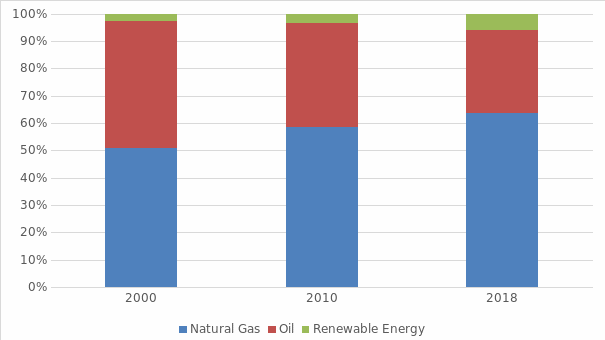
Being the largest producer of the substance globally, it contributes to the creation of immense amounts of CO2 and greenhouse gases, further worsening the local air pollution and climate change issues (Alshammari, 2020). From the economic point of view, the use, export, and trade of oil are profitable for the country; evidently, it has been one of the primary reasons for its stable and drastic development. Conversely, if this trend continues, the region’s resources will be depleted in less than three decades, which creates a significant issue for local and global businesses (Alshammari, 2020). If no transition efforts are being made to shift towards renewable energy, fossil fuel extraction will have an adverse effect on the worldwide economy (Alshammari, 2020). Thus, the city has to invest in developing renewables to enhance the quality of life in the capital and prepare for the future in a long-term perspective.
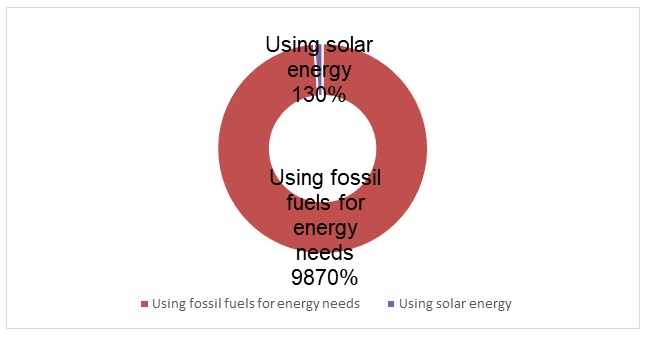
The Circular City
As the preferable option for food waste management, Baig, Gorski, and Neff (2019) highlight that reducing waste as a whole is the most effective approach. In more detail, this campaign will increase awareness of food mismanagement that many people in Riyadh operate on and educate the residents on the necessity of disposing of food sustainably. Merely reducing the amount of food purchased and then disposed will be the most effective solution to the End of Life issue. In addition, feeding people in need with repurposed and repackaged food items can be another direction of development. According to Baig, Gorski, and Neff (2019), it is in the regional culture’s core to help those in need. Non-profitable organizations are already doing their part by distributing food products among the disadvantaged, and their contribution to mitigation of food mismanagement is growing consistently.
To achieve the ideal circular economy and close the bioresources’ loop, more local companies should develop programs to repurpose, resell, or redistribute their food to those in need. In case the food items are not able to be repackaged, they should cascade back into consumption as animal feed or compost for enriching the soil’s potential. Baig, Gorski, and Neff (2019) also highlight organic waste in the industrial landscape: this strategy includes using food waste for methane gas production that would otherwise require additional costs. This strategy will minimize waste and reduce costs for agriculture, which will, in turn, contribute to the local development of food production and reduce the need in imported goods.
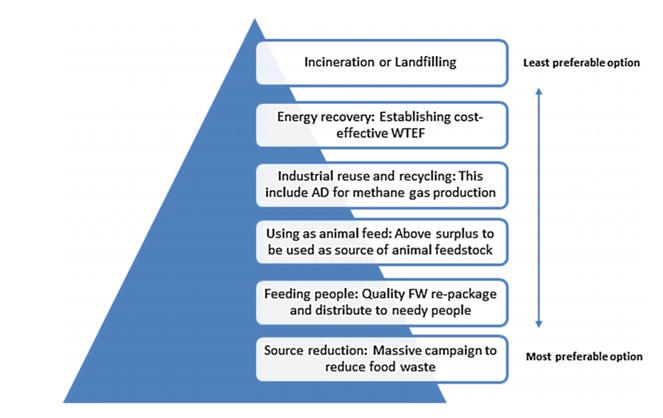
Lastly, one of the optimal decisions for tackling waste management is turning organic disposables into biodiesel. According to Rehan et al. (2018, p. 17), “waste cooking oil (WCO), waste animal fats, and agricultural wastes” that come as direct by-products of the circular loop of bioresources can serve as the foundation for significantly cheap biodiesel manufacturing. This development will help provide enough sustainable energy to support the 8% rise in energy needs, growing each year (Rehan et al., 2018, p. 17).
Table 1. Predictions of biodiesel value for Saudi Arabia, based on Rehan et al. (2018, p. 17).
Another potential point of development to compensate for the needed reduction of fossil fuel energy is renewable energy sources that can serve as another circular economy creation source. For instance, Alotaibi et al. (2018) estimate that if the capital switched to wind-generated energy, the losses in terms of the population’s health would be decreased by at least 20% in less than five years. In addition to diminishing the citizens’ health and minimizing the residents’ quality of life, fossil fuels’ usage contributes to the growing issue of resource depletion. Conversely, this issue does not apply to renewable sources since energy can be harvested with no harm to its origin. According to Alotaibi et al. (2018), the solar and wind power sources have eight times more potential for generating enough energy for the prospected growth in population’s needs. Thus, the circular Riyadh needs to implement renewable sources as a part of the global transition.
The Implementation: A Bumpy Road to Change
Although the initial analysis and overview of the needed change showcase that a drastic shift in energy consumption is necessary for Riyadh, current initiatives and efforts are associated with this change. For instance, the local government introduced its greener outlook on the future in its Vision 2030 plan, which includes three areas of improvement: economic, environmental, and social. More specifically, many efforts are directed towards increasing renewables, such as solar and wind energy. In the near future, the government projects to reduce its oil and natural gas dependence by 2023 (Samargandi, 2017). As it concerns the wind energy efforts, the local officials claim that due to the high potential of wind energy production, they are now investing into the establishment of the relevant technology and institutions. They are going to provide around 10W of energy annually, create more than 7,500 jobs, and contribute approximately 15 million US dollars to the country’s gross domestic product (Samargandi, 2017, p. 868).
While there are ongoing campaigns of switching to renewable energy and closing the bioresources’ loop, the number of challenges and limitations remain. Firstly, the geographical and climatic factors, such as the region’s “humidity, dust, and high temperature” can pose a significant threat to the development and successful operation of the technology (Samargandi, 2017, p. 868). These factors put the existing efforts at risk and stop investors from considering future projects. Secondly, the primary barriers to change are the technical ones, which include a lack of existing waste separation practices in the capital. The absence of the needed infrastructure for waste management and separation also perpetuates the issue of low awareness about the need for mindful garbage disposal and minimal funding for the development of the required facilities.
Furthermore, citizens themselves do not recognize waste as recyclable and view the separation efforts as useless and non-profitable. This barrier is mostly related to the more global “lack of familiarity with the economic opportunities associated with waste management” among citizens, policymakers, and investors (Samargandi, 2017, p. 869). Lastly, from the technological viewpoint, the absence of the legal framework and taxation strategies to regulate the development and implementation of renewables and waste management diminishes the efforts’ productiveness.
Another set of factors that disturb the switch from linear to a circular economy in Riyadh is economic concerns. As mentioned in the sections above, the natural gas industry serves as the primary contributor to the economic growth and energy generation in the region (Samargandi, 2017). In comparison with renewable energy, natural gas is much cheaper in the country, which poses a challenge for the needed change. Saudi Arabia is the sixth most significant producer of natural gas, which is a comparatively greener energy source than coil or oil (Samargandi, 2017). Thus, investors and local businesses hesitate to develop solar and wind facilities in fear of their non-profitability in the face of such a big competitor as natural gas. Apart from the drastic revenue differences, there is a lack of educated professionals and staff to implement and maintain renewable energy facilities, which poses a bigger problem of lack of potential. Lastly, one has to account for the difficulty of renewable energy distribution since solar and wind power is not as easily integrated into the grids of energy providers in comparison with other more familiar types of energy.
In order to perform the needed change to transition to a fully circular economy, Riyadh officials have to complete several steps. Firstly, they have to attract investors and allocate funding for the Research and Development initiatives to develop renewable energy (Mu’azu et al., 2018). Secondly, the government has to implement low- or -zero-interest loans for renewable equipment or starting a business directly related to the process of closing technological and bioresource loops. Furthermore, there has to be a significant development in municipal solid waste management efforts to mitigate the existing issues of landfills. As it concerns the current loop leakages of CO2 emissions, the city officials have to enforce fees and taxation on the harmful substances that are manufactured during energy production (Mu’azu et al., 2018). Conclusively, if the aforementioned efforts are going to be implemented, Riyadh has the potential of becoming a cleaner, more sustainable, and functional circular city.
Reference List
Alotaibi, M. D. et al. (2018) ‘Assessing the response of five tree species to air pollution in Riyadh City, Saudi Arabia, for potential green belt application’, Environment Science Pollution, 27(2), pp. 291-301. Web.
Alshammari, Y. (2020). ‘Achieving climate targets via the circular carbon economy: the case of Saudi Arabia’, Journal of Carbon Research, 6(3), p. 54. Web.
Baig, M., Gorski, I. and Neff, R. (2019) ‘Understanding and addressing waste of food in the Kingdom of Saudi Arabia’, Saudi Journal of Biological Sciences, 26(7), pp. 1633-1648. Web.
Bockholt, M. T. et al. (2019) ‘Learning from the nature: enabling the transition towards circular economy through biomimicry’, 2019 IEEE International Conference on Industrial Engineering and Engineering Management (IEEM), Macao, China, 15-18 December. Web.
Ellen MacArthur Foundation. (2013) Towards the circular economy vol 2.Web.
Fellner, J. et al. (2017) ‘Present potentials and limitations of a circular economy with respect to primary raw material demand’, Journal of Industrial Ecology, 21(3), pp. 494-496. Web.
Kirchherr, J., Reike, D. and Hekkert, M. (2017) ‘Conceptualizing the circular economy: an analysis of 114 definitions’, SSRN Electronic Journal, 127(1), pp. 221–232. Web.
Merli, R., Preziosi, M., and Acampora, A. (2018). ‘How do scholars approach the circular economy? A systematic literature review’, Journal of Cleaner Production, 178, pp. 703-722. Web.
Mu’azu, N. D. et al. (2018). ‘Food waste management current practices and sustainable future approaches: a Saudi Arabian perspectives’, Journal of Material Cycles and Waste Management, 21(3), pp. 678-690. Web.
Rehan, M. et al. (2018) ‘Waste to biodiesel: a preliminary assessment for Saudi Arabia’, Bioresource Technology, 250, pp. 17-25. Web.
Samargandi, N. (2017). ‘Sector value addition, technology and CO2 emissions in Saudi Arabia’, Renewable and Sustainable Energy Reviews, 78(1), pp. 868-877. Web.
Sassanelli, C. et al. (2019). ‘Circular economy performance assessment methods: a systematic literature review’, Journal of Cleaner Production, 229(1), pp. 440-453. Web.
Sposato, P. et al. (2017) ‘Sharing economy and circular economy. How technology and collaborative consumption innovations boost closing the loop strategies’, Environmental Engineering & Management Journal (EEMJ), 16(8), pp. 1797-1806. Web.
Ünal, E. and Shao, J. (2018). ‘A taxonomy of circular economy implementation strategies for manufacturing firms: analysis of 391 cradle-to-cradle products’, Journal of Cleaner Production, 212, pp. 754-765. Web.
Vanhamäki, S. et al. (2020) ‘Transition towards a circular economy at a regional level: a case study on closing biological loops’, Resources, Conservation and Recycling, 156, p. 104716. Web.